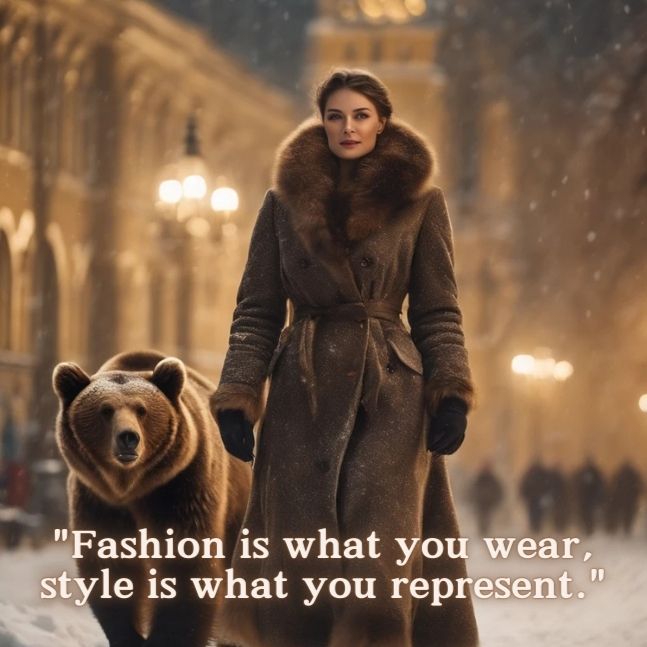
“Russian Fashion Icons: Influencing Global Style Trends”
Fashion is often seen as a reflection of personal taste, cultural trends, and global movements, but in Russia, it has also been an important means of political expression, resistance, and cultural identity. Throughout the country’s tumultuous history, from the Tsarist Empire to the Soviet Union, and through to today’s post-Putin Russia, fashion has been both a tool of state power and a way for individuals and groups to challenge authority and assert their own identity. The intersection of fashion and politics in Russia reveals much about the political climate, societal norms, and the ongoing struggle for personal and collective freedoms.
Fashion and the Tsarist Empire: Symbolism of Power and Status
Under the Tsarist regime, fashion was deeply entwined with notions of power, class, and identity. The nobility and royal family, who ruled Russia for centuries, used fashion as a visual representation of their status and wealth. Elaborate gowns, luxurious fabrics, and intricate designs were not merely aesthetic choices; they were a declaration of aristocratic supremacy. The Romanov family, in particular, was known for its elaborate fashion, with the empresses and women of the court adorning themselves in luxurious attire to reinforce the power of the monarchy.
In contrast, the working class and peasantry were often dressed in practical, humble clothing that reflected their social position. While the upper classes used fashion to signify their power and exclusivity, the lower classes had little access to luxury and were forced to adhere to utilitarian, plain dress. This stark divide in clothing reflected the rigid social hierarchy of the Russian Empire, where fashion served as a clear marker of status and political alignment.
The Bolshevik Revolution and Soviet Fashion: Ideology Through Clothing
The 1917 Bolshevik Revolution marked a dramatic shift in Russia’s political landscape, and this transformation was mirrored in fashion. The new Soviet government sought to create a classless society, where everyone, from factory workers to intellectuals, would dress in a way that reflected their equality. Fashion became a tool for political ideology, used by the state to enforce socialist principles and discourage anything associated with the old Tsarist regime.
In the early years of the Soviet Union, fashion was highly regulated. The government promoted utilitarian and modest clothing to ensure that individuals did not stand out based on their appearance. This emphasis on functional and uniform clothing—often inspired by military uniforms and workwear—reflected the Soviet values of collectivism and labor. The idea was that the working class should not display excess wealth or status through clothing, and that clothing should be affordable and practical for everyone.
However, fashion also became a subtle form of resistance for some. In the 1920s, a small subculture known as the “NEPmen,” the entrepreneurs and wealthy individuals who profited from the New Economic Policy (NEP), used fashion to demonstrate their economic success and defy the government’s ideological push for uniformity. NEPmen flaunted expensive suits and accessories, often imported from the West, as a symbol of their prosperity. This sartorial display of wealth was frowned upon by the government, and many NEPmen were eventually targeted in Stalin’s purges as symbols of bourgeois decadence.
The Cold War and Western Influence: Fashion as a Sign of Rebellion
During the Cold War, as the Soviet Union faced increasing pressure from the West, fashion became an even more potent symbol of political tension. While the Soviet government continued to promote a standard, often drab aesthetic for the general population, the youth in major cities like Moscow and Leningrad (now St. Petersburg) began to adopt Western styles as a form of subtle protest against Soviet repression.
Western fashion, particularly from the United States and Europe, was seen as a symbol of freedom, individualism, and the capitalist system that the Soviet regime opposed. Young people sought to emulate the clothing styles they saw in foreign films, magazines, and on the black market. The 1960s and 1970s saw the emergence of the “stilyagi” (stylish ones), a youth subculture known for their colorful, eccentric clothing and the adoption of Western hairstyles, such as pompadours for men and beehive hairdos for women. The stilyagi, though a small minority, became a form of cultural resistance, using fashion to express their desire for greater personal freedom in a society that stifled individuality.
The stilyagi were not the only group to use fashion as a form of rebellion. Throughout the 1980s, as Gorbachev’s policies of glasnost (openness) and perestroika (restructuring) began to take hold, there was a resurgence of Western influence in Russian fashion. Jeans, leather jackets, and designer labels became symbols of defiance and aspiration, representing a desire to break free from Soviet restrictions and embrace the globalized world.
Post-Soviet Russia: Fashion as a Tool of National Identity and Political Expression
The collapse of the Soviet Union in 1991 ushered in a new era for Russia, and fashion once again became a powerful tool of political expression. As Russia opened up to the West, fashion became an important marker of national identity and a way to assert new freedoms. In the 1990s, as the country transitioned from communism to a market economy, the fashion scene saw a mixture of Western influences, Soviet nostalgia, and a growing sense of Russian pride.
During this period, Russian designers such as Vyacheslav Zaitsev, who had previously been restricted under Soviet rule, began to emerge as international fashion icons. Zaitsev and others combined traditional Russian elements with contemporary Western styles, creating a distinctly Russian aesthetic that appealed both at home and abroad. Fashion became a way for many Russians to reconnect with their cultural roots while simultaneously embracing a more globalized outlook.
At the same time, fashion in post-Soviet Russia also became increasingly linked to political power. In the 2000s, under President Vladimir Putin, the Russian elite began to embrace ostentatious displays of wealth through fashion. High-end brands, luxury goods, and custom-tailored suits became symbols of the new oligarchic class that emerged following the collapse of the Soviet Union. Fashion, in this case, became both a symbol of political influence and a means of projecting power and authority on the international stage.
Putin himself, with his carefully curated image, is a master of using fashion for political purposes. His preference for a well-tailored, militaristic style—often in the form of leather jackets or tailored suits—reinforces his image as a strong and decisive leader, harking back to Russia’s historical image of power and authority. Putin’s fashion choices are not just about personal style, but are carefully chosen to project a specific political persona both domestically and internationally.
Fashion in Contemporary Russia: Political and Social Commentary
Today, Russian fashion continues to reflect the country’s complex political landscape. Designers such as Ulyana Sergeenko and Igor Chapurin often blend Russian traditions with modern sensibilities, drawing on the country’s rich cultural history while embracing a more globalized approach to fashion. At the same time, Russia’s youth culture continues to use fashion to express political opinions and social critiques.
For example, streetwear brands and independent designers have become increasingly popular among young Russians, many of whom see these brands as a form of rebellion against state censorship and the political status quo. Designers like Gosha Rubchinskiy, who incorporates elements of skate culture, Soviet nostalgia, and working-class aesthetics, are gaining international recognition while remaining deeply connected to the realities of Russian life.
Fashion in contemporary Russia also reflects the ongoing tensions between Western and Eastern influences. While many Russians continue to embrace Western fashion trends, others argue for a return to traditional Russian values, using fashion to promote a sense of national pride and resistance to foreign influence.
Conclusion: Fashion as Political Power
The relationship between fashion and politics in Russia is complex and multifaceted. Fashion in Russia has long served as a tool for both political power and resistance, from the days of Tsarist excess to the utilitarian aesthetics of the Soviet Union, to the flamboyant displays of wealth in post-Soviet Russia. Today, fashion continues to be a powerful means of political and social expression, with designers, youth subcultures, and the elite using clothing to negotiate identity, challenge authority, and reflect the ever-shifting political landscape of Russia. In this way, fashion in Russia is not just about style—it is a potent form of political commentary and resistance, one that has adapted to each era of Russian history while remaining a key tool for expressing individual and collective identity















